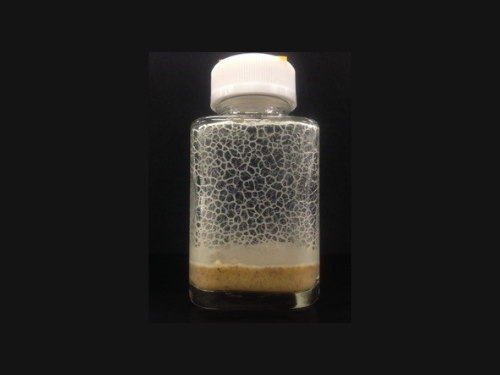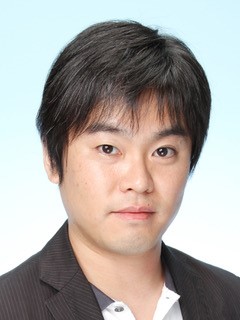By Hiroshima University Department of Public Relations
This photo shows dynamical networks of C. elegans worms formed inside a bottle. (Courtesy Takuma Sugi)
It would have been easy to dismiss the geometrically patterned bottles as room decor. Only in the laboratory of Hiroshima University Associate Professor Takuma Sugi, these weren’t artsy displays. If you look closer, you would see that the bottles’ crisscrossing designs were alive, formed by hundreds of thousands of C. elegans worms, each one as big as the period at the end of this sentence.
These worms are eyeless, but they know their place in the formation. They are leaderless, but they can form ordered patterns. They are goalless, but they seem to anticipate their neighbors’ direction and meet up with them.
Systems like this — exhibiting coherent collective behavior even without a central authority orchestrating the movements — are examples of active matter. And its many forms are all over in nature.
“People, both non-scientists and scientists, are fascinated with collective pattern formations as in flocks of birds and schools of fish,” Sugi said.
He explained that animals, including humans, collectively self-organize to increase their survival and reproduction rate. Swirling flocks of starlings could confuse predators into thinking they’re one colossal beast. And schools of snappers can increase their odds of successful reproduction.
“Each animal does not know its own position in collectives,” Sugi said. Yet somehow, flocks of birds and schools of fishes can move around and abruptly change direction as one without colliding or straying away from the pack.
“Why can randomly moving animals form ordered patterns even without a leader?” he raised.
Such behavior is absent in low-density groups. This capability is unlocked only when there is enough of them to form a flock, school, or swarm. Sugi is decoding the algorithms that propel these smart swarms. But doing controlled experiments in a laboratory with these numbers is unthinkable.
“Understanding a mechanism underlying collective pattern formation requires both theoretical and experimental studies. But no one could hope to do controlled experiments with 10,000 real birds or fish,” he said.
Their research on the feats accomplished by bundles of this microscopic animal was one of the 34 studies highlighted in 2019 by Nature Reviews Physics, a scientific journal belonging to the prestigious Nature portfolio.
“We investigated the mechanism underlying this animal’s collective behavior from the perspective of physics,” he said.
The next step, he added, is to examine collective behavior in C. elegans from the viewpoint of neuroscience and genetics using genome editing techniques, a matter he had accomplished in this worm before. Nearly eight years ago, he and fellow scientists used TALEN gene-editing technology to create a mutation in the worm’s AMPA-type receptor linked to defective sensory behavior.
In their active matter study, Sugi observed that mutant worms move at a curvier trajectory and form tighter networks than non-mutants.
“We would like to know the neural computation driving collective behavior.”
Sugi is now working on a new microscopy technique that will allow them to investigate the neural circuit basis of the worm’s collective behavior and its decline in real-time. With a life cycle of two weeks, this worm can offer insights into how its neural circuit function dwindles as it ages.
“We are often fascinated with the emergence of more intelligent behaviors when living things collectively self-organize at the population level. Our ultimate research purpose is to understand the origin of this intelligence.”
(Research news authored by Mikas Matsuzawa)


 Home
Home



